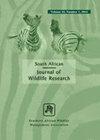Community Attitudes and Perceptions Concerning Rhinoceros Poaching and Conservation: A Case Study in Eswatini
引用次数: 5
Abstract
Rhinoceros poaching has been recognized the world over as a conservation crisis, the result of the high price of horn and demand in Asian markets. The commitment and participation of local people in conservation activities, however, are crucial for conservation success. Here we assess attitudes and perceptions towards rhino poaching and conservation in light of surveys in two local communities adjacent to the Hlane Royal National Park in eSwatini where perhaps 100 black (Diceros bicornis) and white (Ceratotherium simum) rhino occur. Our survey of 60 households addressed perceptions and attitudes towards rhino conservation and willingness to participate in rhino poaching and conservation activities. No efforts have been made to involve local people in conservation activities, and the people do not benefit from the park's activities. About 20% of respondents expressed their willingness to help rhino poachers provided they are paid for their services. Of the remaining 80%, some mentioned that they would not help poachers for fear of being apprehended. Still, some mentioned that they would not help poachers because of their concern about poaching and believe its prevention is important. Park authorities here and elsewhere could invest in building better people–park relationships, and provide opportunities for local communities to participate in conservation activities. Conservation policies to co-manage the resources could be used to deter poaching and to conserve wildlife involving local community members in monitoring and enforcement strategies.社区对犀牛偷猎和保护的态度和看法——以斯威士兰为例
犀牛偷猎已被世界公认为一场保护危机,这是犀牛角价格和亚洲市场需求高的结果。然而,当地人对保护活动的承诺和参与对保护的成功至关重要。在这里,我们根据对斯威士兰Hlane皇家国家公园附近两个当地社区的调查,评估了人们对犀牛偷猎和保护的态度和看法,那里可能有100头黑犀牛(Diceros bicornis)和白犀牛(Ceratothium simum)。我们对60户家庭进行的调查涉及对犀牛保护的看法和态度,以及参与犀牛偷猎和保护活动的意愿。没有努力让当地人参与保护活动,人们也没有从公园的活动中受益。约20%的受访者表示愿意帮助犀牛偷猎者,前提是他们的服务得到报酬。在剩下的80%中,一些人提到他们不会帮助偷猎者,因为他们害怕被逮捕。尽管如此,一些人提到,他们不会帮助偷猎者,因为他们担心偷猎,并认为预防偷猎很重要。这里和其他地方的公园管理部门可以投资建立更好的人与公园关系,并为当地社区参与保护活动提供机会。共同管理资源的保护政策可用于阻止偷猎和保护野生动物,让当地社区成员参与监测和执法战略。
本文章由计算机程序翻译,如有差异,请以英文原文为准。
求助全文
约1分钟内获得全文
求助全文

 求助内容:
求助内容: 应助结果提醒方式:
应助结果提醒方式:


